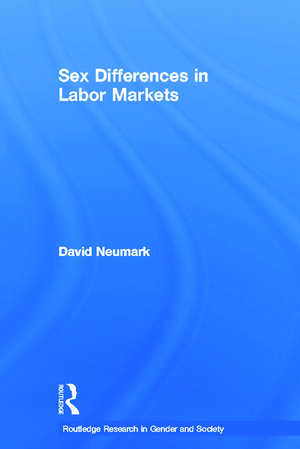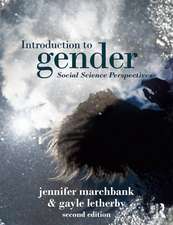Sex Differences in Labor Markets: Routledge Research in Gender and Society
Autor David Neumarken Limba Engleză Paperback – 13 sep 2012
This volume brings together David Neumark's work of the past fifteen years: in it he tries to understand and analyze the relative importance of family economic decision-making and sex discrimination in generating sex differences in labor markets. Neumark's research covers three main levels of inquiry. The first studies non-discriminatory sources of sex differences in labor markets; the second grapples with the problem of sex discrimination; while the third evaluates policies to combat and reduce sex differences in labor markets.
| Toate formatele și edițiile | Preț | Express |
|---|---|---|
| Paperback (1) | 475.70 lei 6-8 săpt. | |
| Taylor & Francis – 13 sep 2012 | 475.70 lei 6-8 săpt. | |
| Hardback (1) | 1344.64 lei 6-8 săpt. | |
| Taylor & Francis – 29 ian 2004 | 1344.64 lei 6-8 săpt. |
Din seria Routledge Research in Gender and Society
- 5%
 Preț: 307.44 lei
Preț: 307.44 lei -
 Preț: 385.20 lei
Preț: 385.20 lei -
 Preț: 148.25 lei
Preț: 148.25 lei -
 Preț: 310.45 lei
Preț: 310.45 lei -
 Preț: 278.93 lei
Preț: 278.93 lei - 9%
 Preț: 1037.59 lei
Preț: 1037.59 lei -
 Preț: 312.34 lei
Preț: 312.34 lei - 8%
 Preț: 389.00 lei
Preț: 389.00 lei -
 Preț: 311.41 lei
Preț: 311.41 lei -
 Preț: 306.80 lei
Preț: 306.80 lei -
 Preț: 287.05 lei
Preț: 287.05 lei -
 Preț: 310.22 lei
Preț: 310.22 lei -
 Preț: 310.41 lei
Preț: 310.41 lei -
 Preț: 310.81 lei
Preț: 310.81 lei -
 Preț: 361.84 lei
Preț: 361.84 lei -
 Preț: 306.99 lei
Preț: 306.99 lei -
 Preț: 287.19 lei
Preț: 287.19 lei - 5%
 Preț: 300.55 lei
Preț: 300.55 lei -
 Preț: 393.65 lei
Preț: 393.65 lei -
 Preț: 483.92 lei
Preț: 483.92 lei - 9%
 Preț: 1106.45 lei
Preț: 1106.45 lei - 28%
 Preț: 821.53 lei
Preț: 821.53 lei -
 Preț: 431.35 lei
Preț: 431.35 lei -
 Preț: 497.20 lei
Preț: 497.20 lei -
 Preț: 488.51 lei
Preț: 488.51 lei - 18%
 Preț: 1057.89 lei
Preț: 1057.89 lei -
 Preț: 355.13 lei
Preț: 355.13 lei - 18%
 Preț: 1005.04 lei
Preț: 1005.04 lei - 18%
 Preț: 1110.77 lei
Preț: 1110.77 lei - 18%
 Preț: 1117.07 lei
Preț: 1117.07 lei - 25%
 Preț: 766.85 lei
Preț: 766.85 lei - 18%
 Preț: 1060.87 lei
Preț: 1060.87 lei - 18%
 Preț: 1057.05 lei
Preț: 1057.05 lei - 18%
 Preț: 1121.81 lei
Preț: 1121.81 lei - 30%
 Preț: 850.91 lei
Preț: 850.91 lei - 18%
 Preț: 1111.16 lei
Preț: 1111.16 lei -
 Preț: 480.62 lei
Preț: 480.62 lei - 18%
 Preț: 1057.09 lei
Preț: 1057.09 lei - 9%
 Preț: 1040.38 lei
Preț: 1040.38 lei - 18%
 Preț: 1112.34 lei
Preț: 1112.34 lei - 15%
 Preț: 699.79 lei
Preț: 699.79 lei - 18%
 Preț: 1163.63 lei
Preț: 1163.63 lei - 18%
 Preț: 1116.02 lei
Preț: 1116.02 lei - 18%
 Preț: 1115.33 lei
Preț: 1115.33 lei
Preț: 475.70 lei
Nou
Puncte Express: 714
Preț estimativ în valută:
91.02€ • 95.29$ • 75.32£
91.02€ • 95.29$ • 75.32£
Carte tipărită la comandă
Livrare economică 05-19 aprilie
Preluare comenzi: 021 569.72.76
Specificații
ISBN-13: 9780415651684
ISBN-10: 0415651689
Pagini: 432
Dimensiuni: 156 x 234 x 22 mm
Greutate: 0.6 kg
Ediția:1
Editura: Taylor & Francis
Colecția Routledge
Seria Routledge Research in Gender and Society
Locul publicării:Oxford, United Kingdom
ISBN-10: 0415651689
Pagini: 432
Dimensiuni: 156 x 234 x 22 mm
Greutate: 0.6 kg
Ediția:1
Editura: Taylor & Francis
Colecția Routledge
Seria Routledge Research in Gender and Society
Locul publicării:Oxford, United Kingdom
Public țintă
Postgraduate and ProfessionalCuprins
Part One: Family Economics and Sex Differences in Labor Markets 1. Korenman, Sanders D., and David Neumark . 1991. Does Marriage Really Make Men More Productive? Journal of Human Resources U>, Vol. 26, No. 2, Spring, pp. 282-307. 2. Korenman, Sanders D., and David Neumark . 1992. Marriage, Motherhood, and Wages. Journal of Human Resources U>, Vol. 27, No. 2, Spring, pp. 233-55. 3. Neumark, David, and Sanders D. Korenman . 1994. Sources of Bias in Women's Wage Equations: Results from Sibling Data. Journal of Human Resources U>, Vol. 29, No. 2, Spring, pp. 379-405. 4. Blackburn, McKinley, David E. Bloom, and David Neumark . 1993. Fertility Timing, Wages, and Human Capital. Journal of Population Economics U>, Vol. 6, No. 1, February, pp. 1-30. 5. Neumark, David, and Andrew Postlewaite . 1998. Relative Income Concerns and the Rise in Married Women's Employment. Journal of Public Economics U>, Vol. 70, No.1, October, pp. 157-83. Part Two: Testing for Discrimination 6. Neumark, David . 1988. Employers' Discriminatory Behavior and the Estimation of Wage Discrimination. Journal of Human Resources U>, Vol. 23, No. 3, Summer, pp. 279-95. 7. Neumark, David, and Michele McLennan . 1995. Sex Discrimination and Women's Labor Market Outcomes. Journal of Human Resources U>, Vol. 30, No. 4, Fall, pp. 713-40. 8. Neumark, David . 1996. Sex Discrimination in Hiring in the Restaurant Industry: An Audit Study. Quarterly Journal of Economics U>, Vol. 106, No. 3, August, pp. 915-42. 9. Hellerstein, Judith K., David Neumark, and Kenneth Troske . 1999. Wages, Productivity, and Worker Characteristics: Evidence from Plant-Level Production Functions and Wage Equations. Journal of Labor Economics U>, Vol. 17, No. 3, July, pp. 409-46. Part Three: Testing Models of Discrimination 10. Neumark, David . 1999. Labor Market Information and Wage Differentials by Race and Sex. Industrial Relations U>, Vol. 38, No. 3, July, pp. 414-45. 11. Hellerstein, Judith K., David Neumark, and Kenneth Troske . 2002. Market Forces and Sex Discrimination. Journal of Human Resources U>, Vol. 37, No. 2, Spring, pp. 353-80. Part Four: Evaluating Policy Responses to Discrimination 12. Bayard, Kimberly, Judith Hellerstein, David Neumark, and Kenneth Troske . New Evidence on Sex Segregation and Sex Differences in Wages from Matched Employer-Employee Data. Forthcoming in Journal of Labor Economics U>. 13. Holzer, Harry, and David Neumark . 1999. Are Affirmative Action Hires Less Qualified? Evidence From Employer-Employee Data on New Hires. Journal of Labor Economics U>, Vol. 17, No. 4, Part 2, October, pp. 534-69. 14. Holzer, Harry, and David Neumark . 2000. What Does Affirmative Action Do? Industrial and Labor Relations Review U>, Vol. 53, No. 2, January, pp. 240-71.
Notă biografică
David Neumark is Senior Research Fellow in Economics at the Public Policy Institute of California, USA.
Descriere
David Neumarks work on gender and labor markets appears for the first time in one book here with new introductory material.

















